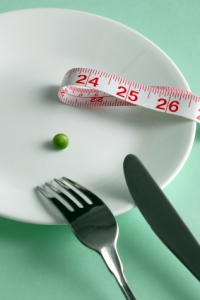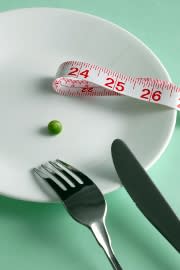I hope the title of his article doesn’t have you thinking that I have found some great shortcut to weight loss.
There isn’t one.

We still don’t have a proven and safe medication, nor do we even have a surgical procedure that we are absolutely sure is safe or even effective in the long-term. As much as my clients would love it if I pulled some magic wand out of my desk drawer and waved it over their head a few times and over the next few days they lost 15 kilograms, it just won’t happen.
As a matter of fact, weight loss is exactly the opposite. It takes hard work, along with awareness and mindfulness, good planning and investing time into proper eating and exercise.
But, what if there was a way to change your focus to make it easier for you to lose weight?
Brian Wansink Ph.D has been researching food-related behaviors for 25 years. His research is fascinating to say the least.
He has concluded that it is easier to change the eating environment than to change your mind. He points out that most of us eat mindlessly and that many of the solutions for that problem go undiscovered because as he says, “we just don’t look for them.” Wansink says we get too focused on eating less of certain foods and more of others or on trying some new-fangled diet we hear about from a friend or read in the newspaper, than on taking a close look at environment around us.
Let’s remember that behavioral change, which is what eating and exercising differently is really all about has two main components: What is my motivation (is it worth it?) levels to change and how is my ability (can I do it?) to change?
If you want to throw willpower into the equation you can, but that rarely brings on permanent and sustainable change. It can be a valuable tool for a while, but ultimately, your willpower will just plain run out. However, not everyone is ready to work on changing their habits full throttle. And one good way to get started is to look at areas other than my food consumption and exercise.
So what factors should I look at in order to find success?
Dr. Wansink says the solution is to tweak our homes, workplaces, schools, restaurant dining and grocery shopping so that we mindlessly eat less instead of more.
So what are some of these tricks? Here’s the first one—always use plates that are not the same color as your food.
In an experiment at Cornell University, people that put white pasta on a white plate or pasta in red marinara sauce on a red plate ate 18 percent more than those who did the opposite and put contrasting plates and foods together. So in your home, don’t use plates that are the same color as the food you put on them.
In another piece of research known as the Syracuse study, Researchers visited 230 homes in Syracuse, NY and took pictures of all the food that was left on their kitchen counters and they weighted the occupants of these homes. The first thing is that the size of the kitchen itself made very little difference, but what food was left out on the counters made a big difference. The average woman who left potato chips on her counter as opposed to having them put away in a food pantry weighed eight pound more. But the most dangerous food to keep out are breakfast cereals. Women who kept the cereal out on the counter, even one box, had an average weight of 21 pounds more than those that didn’t.
One of the reasons this is a big culprit is because the boxes say things like “contains only whole grains” or 11 Essential Vitamins and Minerals. We figure it must be health so we don’t think twice about taking a little extra and then even a little more extra. As Wansink says “In sight, in stomach.”
How do you serve your food?
If you serve family-style, that is, that you put your food in serving bowls and bring those bowls to the table, you are eating 19 percent more than if you bring a plate with the proper portions on it from the kitchen to the dining room. One is much more likely to take seconds or thirds if the food is on the table than to get up and walk a few meters over to the kitchen to take seconds. If you do need to serve family style, bowls with lids are helpful.
Wansink’s research has come up with 150 proven ways to help you lose weight; 100 of them are home-related. Although we can’t enumerate all of these in this article, here are ten tips that will help you keep your weight down that are related to your home environment:
- Serve salad and vegetables first before the entrée and starches are brought to the table.
- The main dish is pre-plated and served from the stove or counter.
- Your dinner plates are 9-10 inches wide (not larger).
- You eat sitting at a table without distractions (like your tablet or laptop computer)
- There are two or fewer cans of soft drinks in your refrigerator at any one time.
- Your kitchen counters are organized and not messy.
- Precut fruits and veggies are now on your middle refrigerator shelf
- At least 6 single servings of protein are in your fridge—eggs, yogurt, string cheese or tofu are some common choices
- Your snacks are kept in one inconvinient place.
- The only food on your kitchen counter is a fruit bowl
In today’s busy world where all of us are overscheduled, not everyone will be able to engage in weight loss through the standard, and even successful ways. But if we can take some time once, and reorganize our kitchen and institute a few rules about how we serve our food, we can all begin the weight loss process without totally overhauling our lives. Making any or all of these small changes just may help you to lose weight and “add hours to your day, days to your year and years to your life.”
Alan Freishtat is an A.C.E. CERTIFIED PERSONAL TRAINER and a BEHAVIORAL CHANGE and WELLNESS COACH with over 19 years of professional experience. Alan is the creator and director of the “10 Weeks to Health” program for weight loss. He is available for private coaching sessions, consultations, assessments and personalized workout programs both in his office and by telephone and skype. Alan also lectures and gives seminars and workshops. He can be reached at 02-651-8502 or 050-555-7175, or by email at alan@alanfitness.com Check out the his web site –www.alanfitness.com US Line: 516-568-5027.
The words of this author reflect his/her own opinions and do not necessarily represent the official position of the Orthodox Union.

